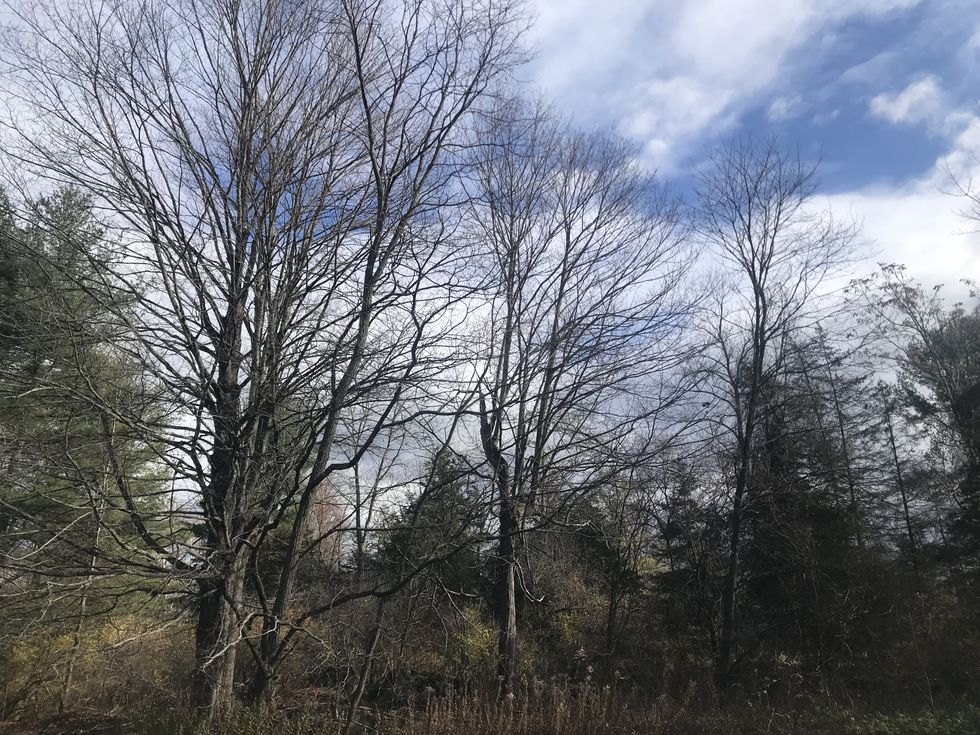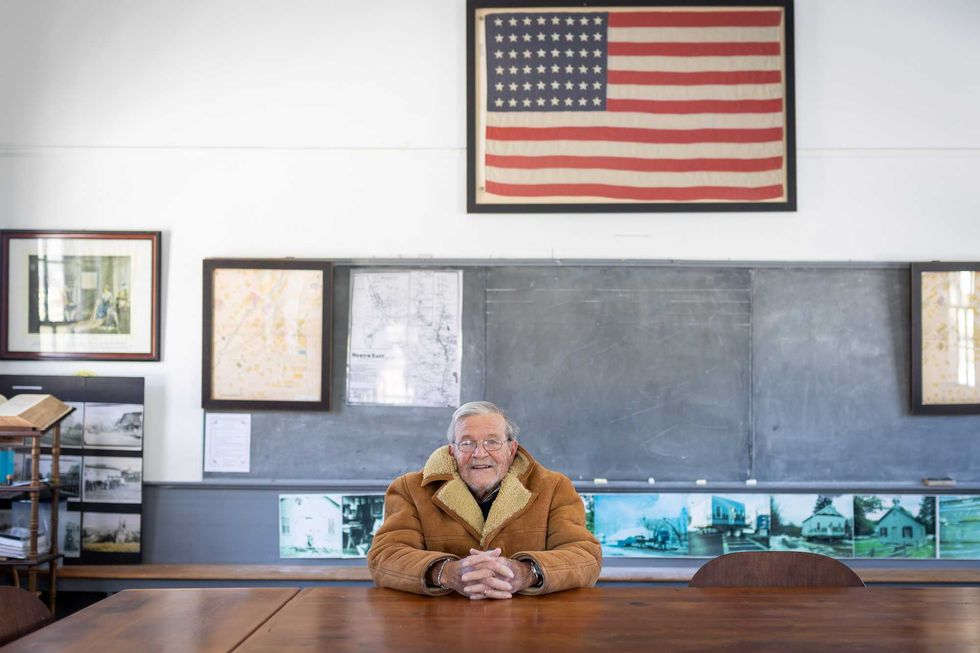Cary Institute talks about carbon credits

The Cary Institute spoke about trees and the impact of climate change in a recent talk.
Photo by Janet Manko

MILLBROOK — Charles Canham, Ph.D. and recently retired from the Cary Institute of Ecosystem Studies, is well versed in the dynamics of forests, their ecosystems and the impact humans have on them. His research in the field, and the use of computer-generated models and statistics, allows him to address how forests respond to human impact, as well as to fire, insects and overall climate change.
He shared his 35-plus years of experience with the Cary Institute audience as he spoke about trees and forests and carbon credits on Thursday, Nov. 11.
Canham has become an expert at studying and explaining Forest Carbon Offsets, which offer a tradable certificate or permit that allows a company, country or other entity to emit or spend a given amount of carbon dioxide or an equivalent greenhouse gas. A single carbon credit equals 1 ton of either carbon dioxide or other greenhouse gas emission.
While this practice began in as attempt to lower global emissions and to promote clean energy, many are uncertain if it will work. Some see serious problems with the plan.
It basically began with the Kyoto Protocol, an international treaty to reduce greenhouse gas emissions (GGE). It applies to six greenhouse gases: carbon dioxide, methane, nitrous oxide, hydro fluorocarbons, per fluorocarbons and sulfur hexafluoride. It is an extension to the 1992 UNFCCC treaty.
When companies buy and sell carbon credits, the money goes to fund carbon offset projects, meant to eliminate the amount of carbon dioxide equal to the amount emitted.
The premise sounds good, said Canham. The country or company receives a set of quota of credits, depending on the size of the company or properties or what their function is.
The amount of credits can vary each year and can be used throughout the year. If the entity goes over the allotted credits, there are severe penalties.
Each country or company gets a set of number of credits. The amount depends on their size and what they do.
Every year they get a new set of credits, which can be used throughout that year.
It is worth noting there has been very little change in carbon reduction practices since the Kyoto Protocol began.
Canham used an example of the Nature Conservancy, which is currently conducting a self-examination of its carbon offset portfolio. A nonprofit, it is developing over 20 carbon offsets of forest areas, mainly in the United States, with companies such as JP Morgan Chase & Co., BlackRock Inc., and Walt Disney Co. The companies use the credits to claim reductions in their own projects and expended emissions.
The Nature Conservancy is concerned that it could be helping to sell useless carbon credits to its corporate clients. Last year it was discovered that the largest environmental group, active worldwide, was claiming credits for forested areas that were not in danger of being destroyed. In other words, getting credit for doing absolutely nothing.
Canham and Cary Institute President Joshua Ginsberg discussed at the Nov. 11 presentation the fact that there are pros and cons to obtaining carbon offsets. As with any credit system, it can be abused. It also may promise more than it can deliver.
So how much carbon do U.S. forests store each year? How does that number change when one includes urban trees, furniture and harvested wood products? Well, in 2018, the 691 million acres of U.S. forestland sequestered 564.5 millions tons of C02.
This means the net sequestration across all five categories offsets 11% of total U.S. greenhouse gas emissions annually.
Canham showed an image that showed that all not all of this country’s forestland is a carbon sink. The Eastern U.S. is a sink equaling 85% of total forestation sequestration; the Rocky Mountains is a source due to the effects of fire and insects; the Pacific Coast is a sink, with a high biomass and sequestration rates but is also threatened by fire.
Natural climate solutions can put unrealistic demands on the forests yet there is a possibility of climate mitigation potential by 2025 by raising the price of carbon credits from $10 to $50 per ton, suggested Canham, by halting all harvests on private non-plantation forestland across the U.S., and by making up the lost harvest through reforestation and thinning fire-prone forests in the West.
What can we do to reduce carbon dioxide emissions? Corporations and businesses “can purchase legitimate carbon credits,” said Canham. “Forest owners can evaluate whether joining the forest carbon market is of benefit to attaining global carbon reduction. And for everyone else, use your voices: Demand transparency in net zero goals and in the methods used for valuing carbon credit projects.”
Ralph Fedele sits at a desk in the historic Irondale Schoolhouse, which he led the effort to relocate to downtown Millerton.
MILLERTON — After serving for 12 years on the North East Town Board, Ralph Fedele says he has only one regret.
“I wish I could be called a ‘local,’” he joked with a warm, booming laugh.
Fedele moved to Millerton from New York City 37 years ago, in 1988, and has since worn many hats — volunteer, historian, advocate, elected official — yet he still doesn’t believe he’s earned that title.
“I’m a transplant,” he said matter of factly. “I’m from the city.”
Before settling in Millerton, Fedele spent 25 years working in merchandising at JCPenney.
His roots, however, trace back to Rhinebeck, where he grew up on a 97-acre farm and enjoyed what he describes as an idyllic childhood.
“It was marvelous,” he said, with a twinkle of nostalgia in his eyes. As a boy, he climbed apple trees, spent hours in the family barn’s hayloft, played with neighbors until sunset, and helped his Sicilian grandmother — his nonna — in the garden. Today, Fedele wears her ring. “Any time I’m a little depressed or I want to remember,” he said, “I can talk to her.”
Growing up with an Italian grandmother sparked a lifelong love of history and culture. That curiosity eventually took Fedele to Italy, where he visited the church in which his grandmother was baptized. “Because I love history so much, I wanted to know where my grandmother was from, so I traveled to her village in Sicily.”
Along the way, he uncovered another piece of family history. His great-grandfather, Giovanni Nicolini, was a noted Italian sculptor whose work still stands outside Palermo’s Teatro Massimo, the largest opera house in Italy. Fedele later made a pilgrimage there and photographed his ancestor’s name on the bronze plaque outside of the theater.

The Irondale Schoolhouse
Years after settling in Millerton full time, Fedele was driving north on Route 22 when he spotted an old, classic building and couldn’t stop thinking about it.
“It was in dire straits,” he recalled. “Right on the road, but beautiful. I remember thinking, ‘Wouldn’t that be a great building to move into the village?’”
That moment would eventually turn into Fedele’s lasting legacy.
He left his post at the North East Historical Society to found Friends of the Irondale Schoolhouse, leading an eight-year effort to “move, restore, and repurpose the building.”
Supervisor Chris Kennan said the project remains inseparable from Fedele’s name. “Every time I pass by the Schoolhouse, I think of Ralph,” Kennan said. “It was his vision and persistence that enabled this dream to become a reality.”
Fedele joked that people may have thought he was crazy during the lengthy restoration. “I was a tyrant,” he said with a laugh. “I really made sure that we were able to get it done.” The effort required coordination with the state, the county, village and town officials, and his newly assembled nonprofit board.
As a self-proclaimed history buff, Fedele didn’t stop at the restoration. He found a list of students in old records and did what any determined historian would do. He opened the telephone book and started making calls.
Eventually, he tracked down one of the schoolhouse’s original students — Mary (Mechare) Leitch — who, at the age of 101, returned to the building after renovations were complete.
“It was a marvelous time,” smiled Fedele. “I was so happy to see her.”
‘Trust is earned’
Today, even though he won’t call himself a local, Fedele is a familiar fixture in town. You can find him each week enjoying conversation and a cup of coffee at Talk of the Town Deli, or getting stopped in town by neighbors and friends for a chat.
“I have gained the trust and confidence of a lot of people,” Fedele said. “It comes a little bit at a time. Trust is earned.”
Not only has Fedele served as a town board member, he has volunteered for Townscape and served as the president of the North East Historical Society. He was also one of the first advocates of preserving history by fixing toppled gravestones at the Spencer’s Corners Burying Ground.
His service was formally recognized at his final Town Board meeting through a resolution commending his three four-year terms as councilman, citing his “good humor, kindness to all and deep concern for the community’s senior citizens and for those living on fixed incomes.”
An emotional Fedele addressed the room with a mantra he often repeats. “When you leave, leave this place a little bit better than you found it,” he said. “That’s what I have always tried to do.”
Neighbors react
During the public comment, several residents stood to thank Fedele.
Claire Goodman, a member of the village Zoning Board of Appeals and Townscape volunteer, said Fedele was among the first to welcome her to Millerton.
“Whether we’re standing out in the cold, scrubbing tombstones at Spencer’s Corners, or ringing the bell at the schoolhouse, you always have such grace and you’re such a gentleman.” She added, “The way you laugh, it opens my heart.”
Kathy Chow, who serves on the Conservation Advisory Council and the Climate Smart Task Force, referred to Fedele as a “pitbull,” adding, “We all have hard things that we do, and we keep pushing at it, but you’re the one who makes me think I can keep going.”
Fedele describes his retirement from the town board as bittersweet. “I’m going to miss this,” he said. “I really am.”
Mad Rose Gallery on Route 44 in the Village of Millerton is decked out with lights and decorations to celebrate the holiday season.
MILLERTON — The Village of Millerton is inviting residents and businesses to enter its annual house decorating contest, with judging now underway through Dec. 28.
Awards will be presented in several categories, including Best Lights, Most Creative, Best Overall and Best Commercial Front.
Entries will be evaluated by a panel of judges using established criteria. Creativity will be judged based on originality, variety of materials used and the use of homemade vs. commercially made decorations. Appearance will consider color coordination, balance and overall attractiveness, while effort will reflect the time and energy put into preparation and presentation.
Judging will be conducted by drive-by observation between 6 p.m. and 11 p.m., and displays must be clearly visible from the street side of the house at night. People and pets may not be included as part of the design.
Winners in each category will receive a gift basket, gift certificates and recognition in The Millerton News. Awards will be distributed on Friday, Jan. 9, 2026.
The contest is open to residents and businesses in the Village of Millerton and the Town of North East. Entry forms can be obtained from Village Hall or at villageofmillerton-ny.gov.